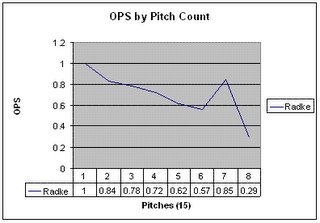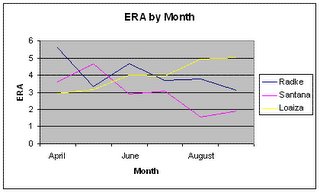In Like a Lion
Radke’s Early Struggles
Brad Radke’s career with the Minnesota Twins has been more consistent than a few Swiss clocks. He has suffered occasional injuries and had a few spikes, like 20 wins in 1997. But for the most part you can pencil Radke in for about 32 starts, an ERA around 4.00, 210 IP, 130 Ks and 35 BBs. Excluding the two years where he made less than 30 starts- one season due to injury, the other during his rookie year-, he has stayed between 3.48-4.49 in ERA for eleven years. The only noticeable change has been a gradual improvement in K/BB ratio due to diminishing BB rate. Not all elements of consistency are so desirable, though, like Radke’s inability to get through the first inning with a lead. Is there any statistical proof backing up every Twins’ fan’s anecdotal understanding that Radke struggles early in the game? That’s what I’m here to find out.
First of all, Radke’s three-year numbers include an .860 OPS-against during the first inning of games compared to a .736 cumulative OPS-against, which seemingly answers the question by itself. In terms of pitch count, Radke’s worst 15-pitch segment is 1-15, where he gives up a .844 OPS-against. For comparison, his next segment, pitches 16-30, sees him improving to a .759 OPS-against, all the way down to .641 for pitches 61-75, which is his best segment. Most of the difference comes from his strikeout rate, which stands at 10.5% of all batters faced, as opposed to 19.1% in his second segment and 16.1% during his best segment. His walk rates do not change appreciably and his homerun rates remain shaky across the board, so it is safe to say that most of the damage is done by extra balls in play. His opponents’ ISO has a similar trend, dropping from a highpoint of .227 early in the game to .185 in the following segment, bottoming out at .168 in his strongest part. To illustrate, here is a line graph indicating how batters tended to hit Radke at a better rate earlier in games.

That seems to confirm the hypothesis, but it doesn't answer the whole question; is Radke really that much worse earlier in games and why? The lower K-rates coupled with higher batting averages and isolated power rates indicate that Radke preserves his pinpoint control, but less movement or command, making his pitches easy to hit and hit hard, like dead ducks over the plate. Recall the discussion of pitchers during spring training: early on, pitchers need to work out their arms to get command of their pitches and they often get the Jose Lima treatment at the outset. Similarly, April is Radke’s cruelest month, where he is 5-8 with a 5.59 ERA in his last 16 starts. Again, hitters do not walk more, but miss less and hit for more power when they do make contact, more evidence that Radke has trouble getting loose or working out the kinks.
The spring training example sheds more light on the situation, though, as Radke is among the legions of pitchers who struggle off the bat (figuratively and literally). Considering the time-honored tradition of starting slowly, Radke is probably not alone in his early season struggles. Here is a graph of Radke, Johan Santana and Radke’s top-comp Esteban Loaiza in terms of ERA by month.

Well, the conventional wisdom that pitchers tire over the season seems to win out over the contradictory conventional wisdom that pitcher’s need time to round into form. How about OPS by pitch count, you ask?

This one makes Radke’s problems look less dire. Santana’s OPS-against on pitches 1-15 is even further from his own cumulative average. Loaiza shows a similar trend. So our conclusions should be twofold: first, Radke’s early-game struggles are overstated. Even though he does pitch poorly in his first fifteen pitches, other pitchers do too as hitters seem to come out better than pitchers (which is consistent with a wider data set I examined but did not include in the graphs). Second, Radke’s real problem is how he starts the season. Giving up 19 HRs in 98 IP over the last three Aprils is a real problem for a team trying to get off to a good start, especially now that they need to reestablish themselves in the division. Here’s hoping he finds a way to channel Santana’s sick Augusts, where he is 14-1 with a 1.52 ERA in his last 18 starts.

0 Comments:
Post a Comment
<< Home